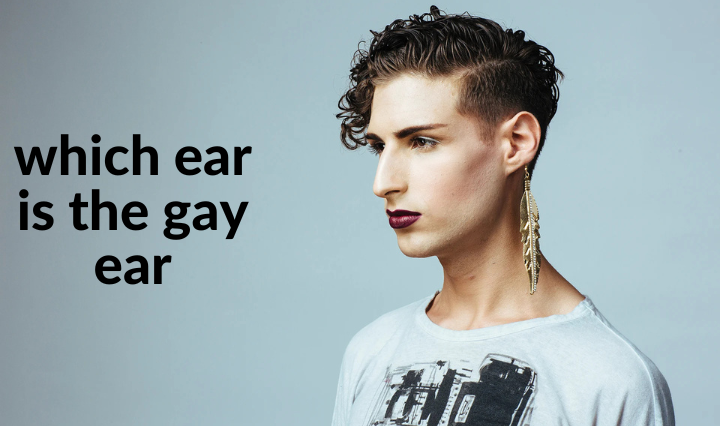Introduction: The Curious Case of “Which Ear is the Gay Ear?
Have you ever heard someone ask, “Which ear is the gay ear?” and found yourself scratching your head, wondering what on earth they were talking about? You’re not alone! This quirky question has been floating around for decades, often tied to outdated stereotypes and cultural myths. But where did it come from? And why does it still pop up in conversations today?
In this article, we’ll take a deep dive into the origins of this question, explore its cultural significance, and debunk some of the myths surrounding it. Whether you’re here out of curiosity or to settle a bet with a friend, you’re in for a wild ride. So, grab a cup of coffee, sit back, and let’s unravel the mystery of “which ear is the gay ear.”
The Origins of the “Gay Ear” Myth
A Blast from the Past: The 1970s and 1980s
The idea of “which ear is the gay ear” can be traced back to the 1970s and 1980s, a time when LGBTQ+ visibility was growing but still heavily stigmatized. During this era, subtle cues and coded signals were often used by queer individuals to identify each other in a world that wasn’t always accepting.
One of these signals was the placement of earrings. Rumor had it that wearing an earring on a specific ear indicated one’s sexual orientation. But which ear was it? Well, depending on who you asked, the answer varied. Some claimed it was the right ear, while others swore it was the left.
The Right Ear vs. Left Ear Debate
So, which ear is the gay ear? According to the myth, wearing an earring on the right ear was said to signify that a man was gay. On the other hand (or should we say, other ear?), the left ear was supposedly the “straight” ear.
But here’s the kicker: this “code” wasn’t consistent across different regions or communities. In some places, the left ear was the gay ear, while in others, it was the right. Talk about confusing!
Why Did This Myth Stick Around?
The Power of Stereotypes
Let’s face it: humans love categorizing things. It’s in our nature to create labels and boxes, even when they don’t make much sense. The “gay ear” myth is a perfect example of how stereotypes can take on a life of their own.
Back in the day, when being openly LGBTQ+ was risky, these subtle signals provided a way for people to connect without drawing too much attention. Over time, though, the myth became less about community and more about assumptions.
Pop Culture’s Role
Pop culture played a huge role in perpetuating the “which ear is the gay ear” myth. Movies, TV shows, and even music videos often used earrings as a shorthand to signal a character’s sexuality. While this might have been groundbreaking at the time, it also reinforced stereotypes that don’t hold up today.
Debunking the Myth: Does It Even Matter?
The Truth About Earrings and Sexuality
Here’s the thing: there’s no universal rule about which ear is the gay ear. Sexual orientation can’t be determined by something as trivial as an earring. Sure, some people might choose to wear earrings as a form of self-expression, but that doesn’t mean it’s a definitive indicator of their sexuality.
Breaking Free from Stereotypes
It’s 2023, and it’s high time we let go of outdated stereotypes like the “gay ear” myth. LGBTQ+ individuals are as diverse as the colors of the rainbow, and reducing someone’s identity to an earring is not only inaccurate but also dismissive of their individuality.
Fun Facts About Earrings and Culture
While we’re on the topic, let’s take a quick detour and explore some fascinating facts about earrings and their cultural significance:
- Ancient Egypt: Earrings were a symbol of wealth and status. Both men and women wore them, often adorned with precious stones.
- Pirates: Ever noticed how pirates in movies always have earrings? It’s said that sailors wore earrings as a form of insurance. If they died at sea, the earring could be used to pay for their burial.
- Gender Norms: In many cultures, earrings have been used to challenge gender norms. For example, in the 1980s, men wearing earrings became a symbol of rebellion and nonconformity.
FAQs About “Which Ear is the Gay Ear”
1. Is there really a “gay ear”?
Nope! The idea of a “gay ear” is a myth rooted in outdated stereotypes. Sexual orientation can’t be determined by which ear someone wears an earring on.
2. Why did people believe this myth?
Back in the day, when LGBTQ+ visibility was limited, subtle cues like earrings were sometimes used as signals within the community. Over time, this evolved into a broader (and inaccurate) stereotype.
3. Should I avoid wearing earrings on a specific ear?
Wear your earrings however you like! There’s no right or wrong way to express yourself.
Conclusion: Let’s Leave the Myth Behind
So? The answer is simple: there isn’t one. What started as a subtle signal within the LGBTQ+ community has turned into an outdated stereotype that doesn’t hold water in today’s world.

